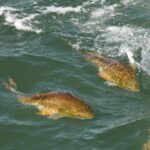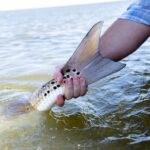
A Veteran Guide’s View of Jacks
If you’ve spent any time on the water in South Florida, chances are you’ve heard
MDDNR studies with American shad, hickory shad, yellow perch, white perch , summer flounder and striped bass have shown that there are two main factors that cause mortality among released fish: physical injury from hook wounds and stress from the physiological exertion from fighting.
Deep-hooking can be influenced by fishing method (bait vs. artificial lures), hook configuration (J-style vs. circle hook), fish behavior and angler experience.
Stress-related mortality can be influenced by temperature (both water and air), salinity and fish size.
When fishing with bait, deep-hooking can be reduced 60-80% by using non-offset circle hooks instead of J-style hooks.
Results of DNR Circle Hook Studies
Deep-Hooking Rate
Year J-Hooks Circle Hooks % Reduction
1999 17.2% 3.4% 80%
2000 15.0% 5.0% 67%
2001 17.1% 6.6% 60%
2002 12.3% 2.4% 80%
Even if a striped bass is deep-hooked with a non-offset circle hook it will die approximately 50% less often than one deep-hooked with a J-style hook.
Results of DNR Circle Hook Studies
Deep-Hooking Mortality
Year J- Hooks Circle Hooks % Reduction
1999 53.1% 23.5% 57%
2000 58.3% 33.3% 43%
Approximately 90% of the striped bass caught in these studies were less than the 18-inch size limit in place at the time.
Results of DNR Circle Hook Studies
Striped Bass less than 18 inches
Deep-Hooking Deep-Hooking Projected Mortality
Rate Mortality (approx.)
Year J-Hooks Circle Hooks J-Hooks Circle Hooks J-Hooks Circle Hooks
1999 15.2% 2.0% 50% 25% 7.6% 0.5%
2000 10.9% 3.3% 50% 25% 5.4% 0.8%
2001 14.8% 3.2% 50% 25% 7.4% 0.8%
2002 9.7% 2.4% 50% 25% 4.8% 0.6%
These studies show that mortality among striped bass that must be released because they are too small can be reduced by about 90%.
STRESS RELATED MORTALITY
Environmental factors such as temperature (both water and air) and salinity, while not under the control of the angler, should be considered as potential contributors to release mortality.
Susquehanna Flats Catch-and-Release Study- 1998
Water Temperature (F) Mortality Rate
57-59F 0.15%
61-62F 4.2%
64-71F 16.4%
A summary of seven catch-and-release studies conducted with striped bass in fresh water (including ours) was published in the North American Journal of Fisheries Management in 2000 by Wilde et al. They reported that the average mortality of striped bass caught in fresh water with artificial lures was 8% at 60F and 18% at 70F.
Time out of water, particularly during hot weather, also increases stress related mortality. High air temperatures have been shown to increase release mortality in both fresh and salt water.
Mortality Rate of Shallow-Hooked Striped Bass
Chesapeake Bay 1999 Fresh Water in Tennessee 1998 *
Air Temp. (F) Mortality Rate Air temp. (F) Mortality Rate
<95F 0.8% 59F 14%
>95F 17.2% 88F 67%
HOOK STYLE COMPARISONS
(deep hooking rates and catch rates)
J-hooks vs. circle Hooks :
Deep hooking rate – J-hooks: 15-17%
Deep-hooking rate – non-offset circle hooks : 3%
Catching efficiency (% of fish landed per strike)
J-hooks: 41.7%
Non-offset circle hooks: 27.4%
Kahle vs. non-offset circle hooks vs .offset circle hooks
Deep hooking rate – Kahle :12.3%
Deep hooking rate – offset circle hooks: 2.8%
Deep hooking rate – non-offset: 2.4%
Catching efficiency (% of fish landed per strike)
Kahle: 41%
Offset circle hooks: 21%
Non-offset circle hooks: 26%

If you’ve spent any time on the water in South Florida, chances are you’ve heard

Photo Credit: Graham Tayloe Big Win for Redfish in Alabama Huge news from the Marine

Feature Photo: Carter Abramson | Simms Fishing at the Fisheries Science Symposium We have more

Each year, hundreds of millions of fish are killed as collateral damage from large-scale, inshore
We rely on our members and donations to keep fighting for a sustainable tomorrow in marine conservation.
GIVE THE GIFT OF FISHERIES CONSERVATION THIS HOLIDAY SEASON. SHOP ASGA GOODS THAT FUND FISHERIES RESEARCH & ADVOCACY CAMPAIGNS
JOIN ASGA IN CALLING FOR CRITICAL MANAGEMENT ACTION AFTER YEARS OF SPAWN FAILURES & POOR MANAGEMENT.
By using this website, you agree to our use of cookies. We use cookies to provide you with a great experience and to help our website run effectively. To learn more, please review our privacy policy.
One Response